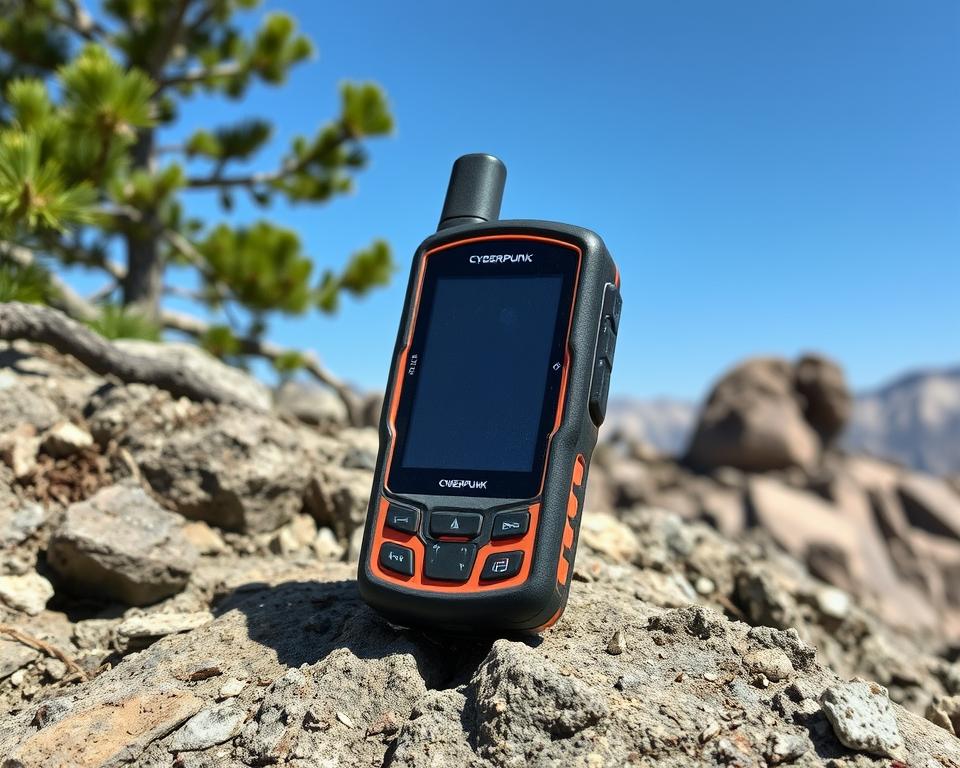I love hiking and have explored waterfalls around the world. This makes me think a lot about whether GPS watches or handheld GPS devices are better. There’s no simple answer to the best GPS for hiking. When you’re deep in nature, picking the right way to stay on track is key. These devices use satellite signals to show where you are, very accurately.
Knowing the differences between GPS types is vital for any adventure. It matters whether you hike often, climb mountains, or trek where no roads go. Think about weight, how long the battery lasts, how big the screen is, and what sensors it has. GPS watches and handheld devices help us follow paths, manage tricky routes, and check the weather with their sensors.
Deciding on a GPS watch or a handheld device depends on what you need and like. GPS watches are easy to wear and always with you. But handhelds have bigger screens and longer-lasting batteries for detailed directions. Thinking about these points helps us pick the best gear for our hikes.
Understanding the Basics of GPS Devices for Hiking
Hiking is thrilling but demands precise navigation. GPS devices meet this need, guiding explorers effectively. Knowing how these tools work is key for any outdoor lover.
What is a hiking GPS device?
A hiking GPS is a device made for outdoor adventures. They come as handheld units or in wearable tech like watches. By catching signals from satellites, they pinpoint your exact spot. This tech is perfect for hiking in places without clear landmarks.
How GPS devices work
GPS gadgets rely on satellites 20,000 km above Earth. Each satellite beams a signal that the receiver catches. With signals from four or more satellites, the device finds its location accurately. Most units find your spot within sixteen feet.
However, things like solar activity can impact signal accuracy. Still, brands like Garmin ensure their GPS tools are reliable outdoors.
Common uses of GPS in hiking
GPS tech is vital for hikers. The key uses include:
- Backcountry mapping: It helps hikers plan routes and understand the land.
- Trail logging: You can log trails, to follow back or share with friends.
- Topographic mapping: Some units offer maps with elevation changes, important for serious hikers.
- Waypoints and tracking: Marking waypoints and tracking keeps you on path in long treks.
- Emergency use: In emergencies, GPS gives exact locations for rescue.
Whether through an app like Gaia GPS or a dedicated unit from Garmin, GPS brings safety and accuracy to hiking. It’s crucial in tough terrains where normal navigation might not work.
Key Features of GPS Watches
When it comes to wearable technology for hiking, one of the most significant innovations is the GPS watch. This versatile piece of hiking gear is not only functional but also convenient to wear at all times, doubling as an everyday outdoor smartwatch. However, there are critical features to consider.
Lightweight and Always Wearable
GPS watch features often highlight their lightweight design. Unlike bulkier handheld GPS devices, navigation wearables such as these can be comfortably worn throughout an entire hike. This eliminates the need to frequently take out a device from your pack, streamlining your adventure and keeping your hands free.
Battery Life Considerations
Battery life is a crucial factor in choosing a GPS watch. The duration can range from several hours to a few days, depending on usage and models. For example, the Suunto Ambit 2 offers 50 hours with a GPS fix every 60 seconds, while the Suunto Ambit 3 can extend to 200 hours under similar settings.
However, newer models with advanced features like color screens may require more frequent recharging, offering as low as 20 hours of battery life.
Screen Size and Usability
The screen size of a GPS watch is generally smaller compared to handheld GPS devices. This size constraint can limit map readability and the amount of information displayed at once. Despite this, the convenience of having a continuously accessible device on your wrist may outweigh the drawbacks of the smaller display for many hikers.
Integrated Sensors (Altimeter, Barometer, etc.)
Many GPS watches come equipped with integrated sensors that elevate their functionality. Key features include altimeters for tracking elevation, barometers for weather forecasting, and electronic compasses. These sensors provide valuable information that can help hikers navigate and make informed decisions in real time.
For example, an altimeter can offer precise elevation data, while a barometer can help predict weather changes, enhancing safety during hikes.
Ultimately, when selecting navigation wearables, it’s essential to weigh the pros and cons of an outdoor smartwatch against the specific needs of your hiking adventures.
Advantages and Disadvantages of Handheld GPS Units
Handheld GPS units are perfect for avid hikers and outdoor lovers. They offer detailed features for navigating through tough terrains. This makes them a trusted tool for outdoor adventures.
Larger screens for better navigation
Handheld GPS units come with big screens. This makes reading maps and following complex paths easier. It’s especially useful when planning routes in detail in the wilderness.
Having a large screen helps when you need to quickly decide which way to go. It is a key benefit for outdoor enthusiasts.
Longer battery life and easy recharging
These devices also have an advantage in battery life. They last much longer than GPS watches, which is vital for long journeys. Being able to change or recharge batteries easily is another plus.
This feature makes handheld units essential for extended trips. It ensures you’re never left without a way to find your path.
Higher durability and ruggedness

Handheld GPS gadgets are built strong to survive outdoor challenges. Their design ensures they can handle rough conditions. This means they can take rain, dust, and drops without breaking.
This durability makes them a trusted partner for any tough adventure. For trekkers who value strong and reliable gear, handheld GPS units are a top choice.
Do Gaiters or Hiking Pants Affect the Use of GPS Devices While Hiking?
When hiking, the choice between gaiters or hiking pants can influence the usability of GPS devices. Gaiters or hiking pants can create varying levels of ease in access to pockets, potentially affecting how often a hiker checks their GPS. Comfort and convenience are vital for navigation accuracy on the trail.
GPS Watches vs. Handheld GPS: Navigational Experience
The difference between GPS watches and handheld units is clear in the navigation experience. GPS watches like the Garmin Fenix 7 alert you with vibrations or beeps if you go off-course. Handheld GPS units, such as the Garmin GPSMAP 67, offer more detailed guidance. Their larger screens let hikers see maps fully, making it easy to change plans quickly.
Off-course notifications and guidance
GPS watches give simple but effective notifications. A watch might vibrate to alert you if you’re veering off the trail or nearing a waypoint. This is very helpful for activities like long-distance trail running, where you need to keep your hands free. In contrast, handheld GPS units have big displays and detailed maps for better visual direction. The Garmin Etrex 32x uses GPS and GLONASS networks for more accuracy and quicker updates.
Planning routes on the go vs. pre-planned routes
Choosing between a GPS watch or a handheld unit affects how you plan your trails. With watches’ smaller screens, it’s easier to follow a route you’ve uploaded before. But handheld units let you change your plan while on a hike. The TwoNav Terra, for example, has a large 3.7-inch screen. This makes it easy to adjust to new conditions, great for serious expeditions and unpredictable settings.
Having a dependable device is key for effective trail guidance. It helps keep your adventure on the right path. Some prefer having both a handheld unit and a GPS watch. This way, they get a good mix of convenience and detailed navigation.

